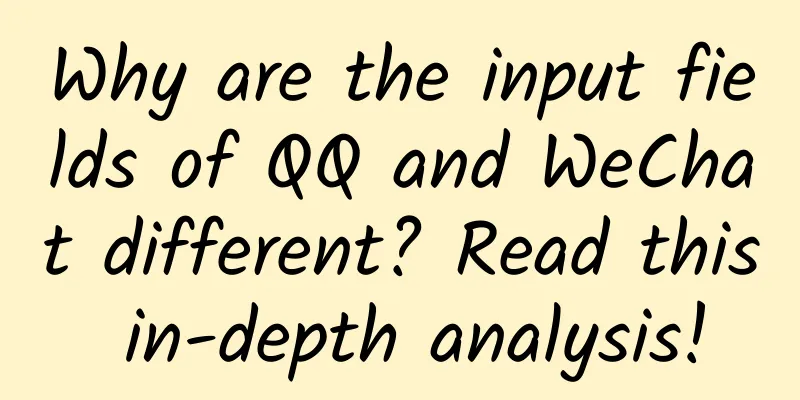Why are the input fields of QQ and WeChat different? Read this in-depth analysis!

|
There are no absolute standards for many issues. What is important is whether we take the initiative to think about the logic behind them. Question 1 Comparison between the original and new iMessage functions in iOS 13.3: What’s better? Why was it changed? One of the updates in iOS 13.3 is the optimization of iMessage, which is a problem that the Apple China team has been working on. In iOS 13.3, the specific change is to divide the messages into: All information;
1. Resolving ambiguity The original segmented control displays "Contacts and regular text messages" and "Not in the address book". Those who observe carefully will find that the information contained in the original "Contacts and ordinary text messages" is actually not the information of known contacts. For example, the notification information of 95595 is not in the address book, so according to the logic of the original version, it should appear in the "Not in the address book" on the right. However, it is still in the "Contacts and regular text messages" on the left. Most of the messages that appear in "Not in the Contacts" are spam. So there is an ambiguity here, that is, "not in the address book" should be changed to "spam" or "filtered messages", and "contacts and ordinary text messages" should be changed to "all messages". Therefore, the new version should be "All messages" and "Filter messages". Then, all messages are divided into "Known contacts" and "Unknown contacts", so the text message content is divided into four modules, namely: All information;
In this way, the segmented control cannot meet the purpose of presenting four types of information, so using a list will be more intuitive. 2. Functional interpretation Users receive a lot of unfamiliar text messages, which cause great interference to them. Differentiating SMS types by "whether the contact is in the address book" can effectively manage unfamiliar SMS. Completely stranger: The source of SMS messages for service login and identity authentication is often not in the address book; Not completely stranger: The contacts in the address book and the source of replied SMS messages are familiar. The benefit of distinguishing between the two is that it allows users to operate more specifically:
Clarifying operations helps to manage information more effectively and optimize storage space. Summarize:
Conclusion: Improve user efficiency. Question 2 Why does WeChat put payment and receipt together, and require one more step to receive payment, while Alipay puts payment and receipt separately on the homepage? The hierarchical processing of functional points in a product is often determined by the positioning of the product itself. When thinking about a problem, everyone should remember one principle: it is meaningless to compare the functions of two different types of products. WeChat is a social platform and Alipay is a super tool. They have different positioning. Discussing why one is like this and the other is not like this would appear one-sided. But in order to answer this student's question, I will still talk about it briefly. The payment and collection function is the highest-level function for the super tool Alipay, but it is not the highest-level function for WeChat (although WeChat payment is great, social networking is still the main focus in WeChat's product design). In addition, for these two products, transactions between acquaintances can be completed using red envelopes or transfers, so before we discuss this issue, we must first assume that the premise is transactions between strangers. When you go out to buy things, you usually pay by scanning the QR code printed by the merchant, or by giving the merchant a customer's QR code to scan to pay. In the merchant scenario, customers rarely use payment collection, unless there is a payment error and the customer overpays. So the merchant needs to pay back the money. In addition to allowing the merchant to operate a full refund and let the customer pay again, the merchant can also use the customer's payment code to transfer the overpaid amount to the customer. However, such scenarios are rare, so the priority of scanning and payment codes will naturally be higher than that of payment codes (not to mention that scanning is a naturally high-priority function). For Alipay, it is understandable to present them separately, after all, the product itself is positioned as a payment tool. For WeChat, however, it seems a bit redundant to put another payment code in the "+" or to split a space in "My" for the payment code to be used for transfer transactions between strangers, after all, there are too few use cases. So it is unnecessary for the social product WeChat to release both, and for the payment tool Alipay, it is also necessary to place payment before collection. Key points. Another key point is that WeChat's "payment and collection" not only refers to payment codes and payment codes, but also includes praise codes, group payments, face-to-face red envelopes, and transfers to bank cards or mobile phone numbers. So for WeChat, payment is not a simple payment, but by definition, it is the entrance to functions related to "payment". If it is convenient for you now, take a look at their order of arrangement. Therefore, this function is difficult to split. Once split, it is no longer a matter of two QR codes, but a problem of 6 sub-functions. This is also why I said earlier that the functions of two different products cannot be simply compared. If you analyze them carefully, you will find that their differences are very large. Question 3 Both are instant messaging products. Why are the bottom input bars of WeChat and QQ different? The number of functions carried by both parties in the bottom bar of the chat page is different: QQ has a total of 19 functions, while WeChat has 12, of which 10 functions overlap. The first four functions of both are basically the same: voice input, pictures, photography, and emoticons. QQ puts "red envelopes" in the fifth place, while WeChat puts "voice calls" in the fifth place. If QQ has the same bottom bar design as WeChat, 17 function points will need to be placed in "More". According to the current layout, it will become 3 pages of sliding (8+8+1). The last function level will be deeper and the usage rate will be lower. In general, the differences caused by the functional arrangements of the two can be summarized as follows: 1. Product positioning As a social platform for acquaintances, WeChat pays more attention to the efficiency and concentration of communication when communicating with others. Their conversations often have clear themes and goals, and they hope to create an efficient and calm conversation environment. QQ's motto "Enjoy communication every day" emphasizes the importance of "fun" while emphasizing communication. 2. User Group WeChat is for users, especially middle-aged and elderly users, and the learning cost cannot be too high, so it is not suitable to have too much content in the conversation, which is easy to confuse users and easy to touch by mistake. Therefore, the tone needs to be more stable and restrained. QQ users are relatively young and have a diverse social group. Therefore, sending emojis, voice changing, camera filter expressions, and red envelopes have different functions to increase interactivity in communication. Similarly, dynamic avatars (frames) and the diversification of chat fonts can make chat content richer, while satisfying basic communication needs and the desire of young people to explore new things. 3. Functional flexibility Functions often depend on strategy and direction. For example, if QQ wants to promote red envelopes, it will move the red envelopes forward. Therefore, the bottom functions of QQ are more in line with the younger temperament in terms of changes. Summary: The product positioning and user groups are different, and there are obvious differences in the way the functions are expressed. QQ functions are more "released", directly displaying functions to attract users to use them, while WeChat knows how to "collect", weakening secondary functions and strengthening primary functions. Strengthening primary functions and weakening secondary functions is also a way to improve user experience. Question 4 There are two mechanisms for seven-day sign-in. One is continuous sign-in, such as Baidu Netdisk. The other is calculated by natural week, such as Palm Life. What is the reason for using these two display methods for the 7-day sign-in function? The check-in function improves user activity, enhances user stickiness, and increases login-registration conversion rates through virtual or real rewards. 7 consecutive days of sign-in. The purpose of continuous sign-in is to motivate users to log in continuously and increase the daily activity of the product by increasing the value of the prizes. There are two key points here, one is the number of days and the other is continuity. 7 days vs. 1 month is more acceptable to users in terms of duration. Although the final rewards are different, the former is better in terms of motivation because it is easier to complete. Unless, the final reward is beyond expectations. If it is continuous, for example, if the user forgets or does not want to sign in one day, then when he comes in the next day, it becomes the first day of signing in, so he simply never participates again. Therefore, this type of tool product usually designs the final reward to be more attractive, and sets a smaller number of consecutive sign-in days to increase user stickiness. Natural Week Sign-in. The advantage of signing in during the natural week is that even if you forget to sign in one day, it will not affect the following days, and it will make it easier for the system to distribute prizes. For example, if a user forgets to sign in on Monday, he can still sign in on Tuesday, but he will not be able to get the sign-in reward on Monday. However, some products can solve this problem by providing a make-up sign-in card. In addition, when users sign in every day, they will see the prizes set by the system to be distributed on that day. For example, those who sign in on Tuesday will receive Christmas hats. This way, administrators can set the type of daily prizes and the number of prizes to be collected in real time based on budget conditions, holidays, hot news and other factors, which will be more flexible for operational work. For example, for 7 consecutive sign-ins, the number of days each person signs in is different, so it is difficult to evaluate the reward. As a result, the continuous sign-in rewards are mostly points and other prizes. Question 5 What is the role of showing dynamic changes in data in rankings? (New hot spots, trends) User: Enhance users’ awareness of the activity of some data and help them filter decision-making information. Product: Displaying the popularity index of data can create a participatory atmosphere, increase the authenticity of information, attract users to view, and play a role in diversion; guide users to view other data besides the top data in the ranking, generate interest in high-popularity content, and play a diversion role. Question: Why does Taobao's hot search list show trend information, but Weibo's real-time hot search list does not? Change frequency difference. Weibo's real-time hot search list is updated quickly, and you can clearly understand the popularity of information just by looking at the ranking, so the trend display is of little significance; Taobao's hot list is updated relatively slowly. In order to guide consumption, trend indicators are provided to help users make decisions. The upward trend will have a psychological suggestion effect of "everyone is buying", stimulating consumers to click in to take a look. Product specificity. Users are sensitive to topic rankings, and icons with a clear downward trend are not conducive to controlling public opinion. For Taobao's hot list, both merchants and users need to know more accurate search trends, that is, upward and downward trends, to understand the popularity of products. |
>>: Cook officially announced iPhone 12, 5G function is basically confirmed
Recommend
Snakes in the Year of the Snake | A land of women among snakes? Like hot springs? These snakes actually have special skills
In the Late Jurassic more than 100 million years ...
Apple internal training document exposed: iPhone 12 dual-SIM mode cannot turn on 5G
This year, all iPhone 12 series use dual SIM dual...
User operation: How to conduct user behavior analysis?
Many students are most afraid of doing open-ended...
Should you lie down, sit, or stand after eating? Doctors give the standard answer...
Expert of this article: Pa Lize, Chief Physician ...
Is slime mold cultivation a new trend? What exactly is this new favorite among young people? !
When you think of pets, what comes to mind? Cats?...
More than 90% of the problems you may encounter when operating Xiaohongshu are here!
In order to facilitate your search, we have categ...
Can breaking bones really increase height? It's not that simple
Growing taller is a beautiful wish of many friend...
How to let old users help you “fission” new users?
The pursuit of user growth is the core goal of op...
Does Cordyceps sinensis have anti-liver fibrosis effects? Can Cordyceps fight liver fibrosis?
Liver fibrosis is a pathological change caused by...
Review summary: Why do cash loan products fail in operation?
This article is a review and summary of the failu...
Case Analysis | How to achieve “unity of knowledge and action” when writing a promotion plan?
Today we are going to talk about writing a planni...
Plug-in hybrid or extended range? Stop arguing! Volkswagen CEO has given the answer: plug-in hybrid models will be launched
Li Xiang, founder of Ideal Auto, recently pointed...
In an age where everyone is swiping their screens, why have wall advertisements become the new favorite of brands?
In the eyes of many people, wall advertising may ...
618 e-commerce advertising battle to gain volume!
618 is coming, which is a big e-commerce node. We...









